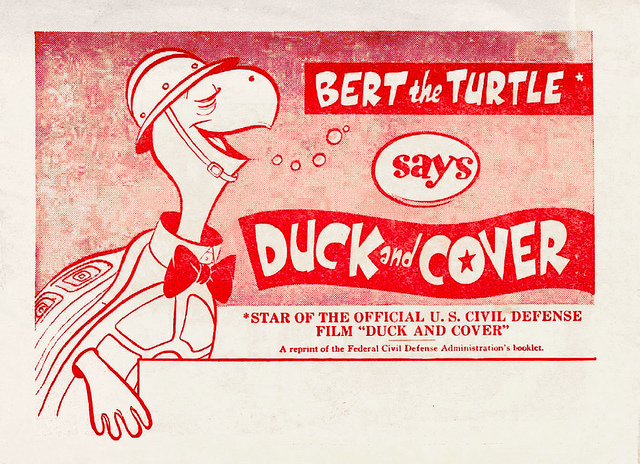Duck and cover was a film created by the Federal Civil Defense Administration (FCDA) in 1952 to provide children throughout the 1950s and 1960s the proper actions to take in the event of a nuclear attack. As a result of the Soviet Union’s “acquisition of nuclear weapons and the first Soviet test detonation in late 1949” the FCDA created propaganda to educate the American public, including children, on the proper actions to take in the event of a nuclear attack.[1] Duck and Cover was a film that was shown in “thousands of schools across the United States . . . complete with a cartoon mascot, Bert the Turtle, and a catchy song.”[2] The film instructs children to “always [be] prepared for danger,” and provide specific direction on what they should do in certain circumstances.[3] One example, the film instructs children how to duck and cover in a school hallway. “Ducking and covering means taking shelter against any kind of structure in the nearby environment: falling to the ground next to a curb, crouching next to a wall, then covering your head and the back of your neck to shield them from injury.”[4] Another example is when “Tony . . . is riding his bike to a Cub Scout meeting when suddenly there is a bright flash. Tony instantly dives from his bike into the gutter next to the curb.”4 Duck and cover became part of American culture, especially for children. It is important to note that “the film leaves no doubt that the threat of attack is always imminent and that the key to the survival of these children is their constant mental state of readiness for nuclear war.”[5] Research has found that the fear of nuclear attack was real as “American children were deeply troubled and worried about the impact of nuclear weapons on their lives. They feared death, the loss of family members and friends, and expressed concern that life in the world left behind by nuclear war might not be worth living.[6]
Duck and Cover was created because it was the government’s response to real fears of nuclear attack during the Cold War. After World War II ended in 1945, the United States and Soviet Union were the only remaining superpowers in the world. As a result, the U.S. and U.S.S.R. “went to work . . . under the cover of ‘socialism’ on one side, and ‘democracy’ on the other, to carve out their own empires of influence.”[7] Under President Truman, the U.S. initiated a policy of “containment primarily through the economic rehabilitation of Western Europe.”[8] Since the U.S. was the only country to pose a nuclear weapon, Truman focused on stopping the expansion of communism and Soviet influence through “economic recovery, . . . even if this meant deferring military preparedness.”8 However, 1949 was a significant year during the Cold War as China became communist, the U.S.S.R. tested an atomic bomb, and the U.S. began to realize the high cost of containment.[9]
In the 1950s, President Eisenhower and Secretary of States John Foster Dulles “crafted a strategy called ‘massive retaliation, which meant using the threat of nuclear warfare to prevent Communist aggression.”[10] Using the U.S. nuclear arsenal would “provide a ‘maximum deterrent at bearable cost’ . . . and would be ‘the deterrent of massive retaliatory power . . . by the means and at times of our own choosing.’10 As a result of this policy, the U.S. and U.S.S.R. engaged in an arms race where each country would attempt to increase their nuclear arsenal and develop strong nuclear bombs. The result of this shift in strategy meant that “massive retaliation … [would turn] every global dispute into a possible war of annihilation.”10 As part of this policy, by 1962 the U.S. invested heavily into nuclear weapons, which resulted in “50 intercontinental ballistic missiles, 80 missiles on nuclear submarines, 90 missiles on stations overseas, 1,700 bombers capable of reaching the Soviet Union, …”[11] It became clear that the arms race and mutual assured destruction was a primary strategy by the United States and Soviet Union, which left the world on the brink of global nuclear war. The Cold War in the 1950s was an era of hysterical fear that gripped the country. Using nuclear weapons as a deterrent forced ‘educators, government officials, and parents [to] realize the necessity, even the urgency, of preparing the country’s youth for a new, more precarious world.’ [12]
[1] Bo Jacobs, “Atomic Kids: Duck and Cover and Atomic Alert Teach American Children How to Survive Atomic Attack,” Film & History 40, no. 1 (2010): 25–44, 27.
[2] Ibid., 28.
[3] Ibid., 29.
[4] Ibid., 30.
[5] Ibid., 31.
[6] Ibid., 37.
[7] Howard Zinn, A People’s History of the United States (New York, NY: HarperCollins Publishers, 2003), 424.
[8] John Lewis Gaddis, Strategies of Containment (New York, NY: Oxford University Press, 2005), 60.
[9] Ibid., 88.
[10] David Emory Shi, America: A Narrative History (New York, NY: W.W
. Norton & Co., n.d.), 1166.
[11] Howard Zinn, A People’s History of the United States (New York, NY: HarperCollins Publishers, 2003), 437.
[12] Bo Jacobs, “Atomic Kids: Duck and Cover and Atomic Alert Teach American Child
ren How to Survive Atomic Attack,” Film & History 40, no. 1 (2010): 25–44, 25.
